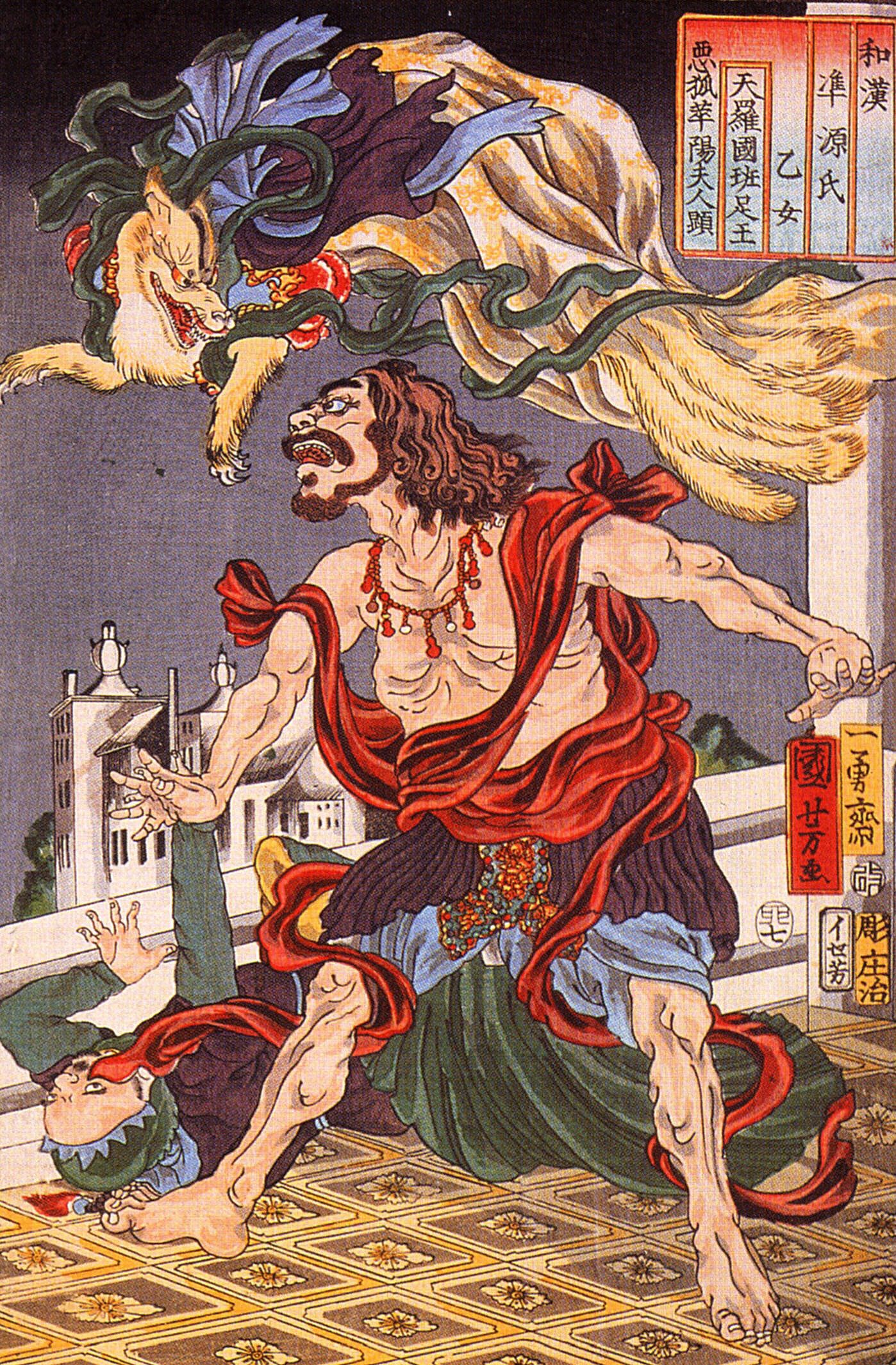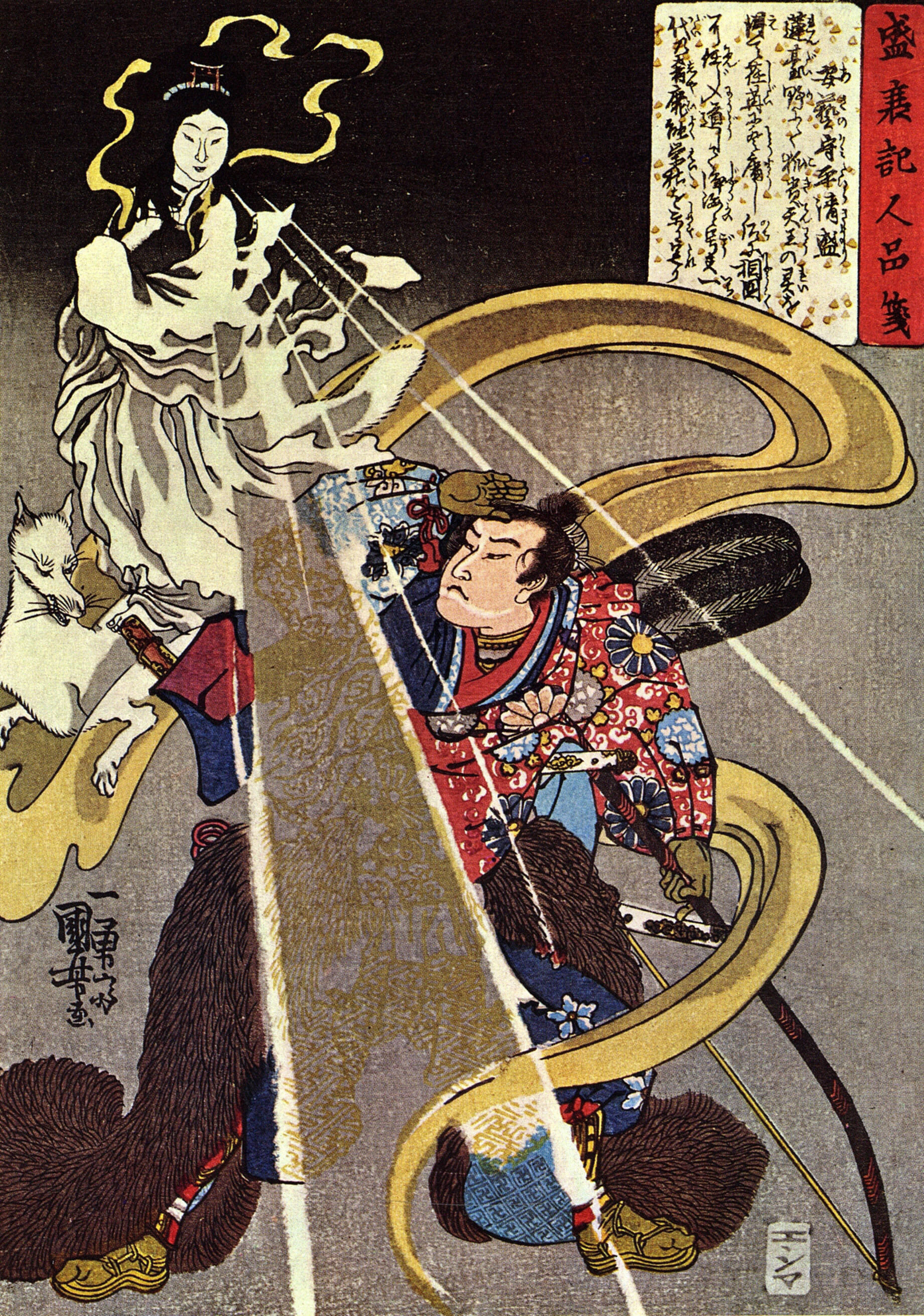|
Hakuzōsu
Hakuzōsu (白蔵主), also written Hakuzosu and Hakuzousu, is the name of a popular '' kitsune'' character who pretended to be a priest in Japanese folklore. Legend The Buddhist monk Hakuzōsu lived in Osaka at the temple Shōrin-ji. He was a believer in Inari Ōkami , also called , is the Japanese ''kami'' of foxes, fertility, rice, tea and sake, of agriculture and industry, of general prosperity and worldly success, and one of the principal kami of Shinto. In earlier Japan, Inari was also the patron of swor ... sama and kept a few kitsunes in his temple. He used these kitsunes to foretell the future. Tsurigitsune The legend of Hakuzōsu became a Kyōgen play, Tsurigitsune (‘Fox Trapping’) / Konkai (‘The Cry of the Fox’) In this story, a hunter is visited by his uncle, the priest Hakuzōsu, who lectures his nephew on the evils of killing foxes. The hunter is nearly convinced, but after the priest departs, he hears the cry of the fox and realizes it wasn't his u ... [...More Info...] [...Related Items...] OR: [Wikipedia] [Google] [Baidu] |
Kitsune
In Japanese folklore, , are foxes that possess paranormal abilities that increase as they get older and wiser. According to ''yōkai'' folklore, all foxes have the ability to shapeshift into human form. While some folktales speak of employing this ability to trick others—as foxes in folklore often do—other stories portray them as faithful guardians, friends, and lovers. Foxes and humans lived close together in ancient Japan; this companionship gave rise to legends about the creatures. have become closely associated with Inari, a Shinto or spirit, and serve as its messengers. This role has reinforced the fox's supernatural significance. The more tails a has—they may have as many as nine—the older, wiser, and more powerful it is. Because of their potential power and influence, some people make sacrifices to them as to a deity. Conversely foxes were often seen as " witch animals", especially during the Edo period (1603–1867), and were thought of as goblins who could ... [...More Info...] [...Related Items...] OR: [Wikipedia] [Google] [Baidu] |
Kitsune (fox)
In Japanese folklore, are foxes that possess paranormal abilities that increase as they get older and wiser. According to ''yōkai'' folklore, all foxes have the ability to shapeshift into human form. While some folktales speak of employing this ability to trick others—as foxes in folklore often do—other stories portray them as faithful guardians, friends, and lovers. Foxes and humans lived close together in ancient Japan; this companionship gave rise to legends about the creatures. have become closely associated with Inari, a Shinto or spirit, and serve as its messengers. This role has reinforced the fox's supernatural significance. The more tails a has—they may have as many as nine—the older, wiser, and more powerful it is. Because of their potential power and influence, some people make sacrifices to them as to a deity. Conversely foxes were often seen as " witch animals", especially during the Edo period (1603–1867), and were thought of as goblins who could n ... [...More Info...] [...Related Items...] OR: [Wikipedia] [Google] [Baidu] |
Japanese Folklore
Japanese folklore encompasses the informally learned folk traditions of Japan and the Japanese people as expressed in its oral traditions, customs, and material culture. In Japanese, the term is used to describe folklore. The academic study of folklore is known as . Folklorists also employ the term or to refer to the objects and arts they study. Folk religion Men dressed as namahage, wearing ogre-like masks and traditional straw capes ('' mino'') make rounds of homes, in an annual ritual of the Oga Peninsula area of the Northeast region. These ogre-men masquerade as kami looking to instill fear in the children who are lazily idling around the fire. This is a particularly colorful example of folk practice still kept alive. A parallel custom is the secretive ritual of the Yaeyama Islands, Okinawa which does not allow itself to be photographed. Many, though increasingly fewer households maintain a kamidana or a small Shinto altar shelf. The Shinto version of the kitc ... [...More Info...] [...Related Items...] OR: [Wikipedia] [Google] [Baidu] |
Osaka Prefecture
is a prefecture of Japan located in the Kansai region of Honshu. Osaka Prefecture has a population of 8,778,035 () and has a geographic area of . Osaka Prefecture borders Hyōgo Prefecture to the northwest, Kyoto Prefecture to the north, Nara Prefecture to the southeast, and Wakayama Prefecture to the south. Osaka is the capital and largest city of Osaka Prefecture, and the third-largest city in Japan, with other major cities including Sakai, Higashiōsaka, and Hirakata. Osaka Prefecture is the third-most-populous prefecture, but by geographic area the second-smallest; at it is the second-most densely populated, below only Tokyo. Osaka Prefecture is one of Japan's two " urban prefectures" using the designation ''fu'' (府) rather than the standard '' ken'' for prefectures, along with Kyoto Prefecture. Osaka Prefecture forms the center of the Keihanshin metropolitan area, the second-most-populated urban region in Japan after the Greater Tokyo area and one of the world ... [...More Info...] [...Related Items...] OR: [Wikipedia] [Google] [Baidu] |
Inari Ōkami
, also called , is the Japanese '' kami'' of foxes, fertility, rice, tea and sake, of agriculture and industry, of general prosperity and worldly success, and one of the principal kami of Shinto. In earlier Japan, Inari was also the patron of swordsmiths and merchants. Represented as male, female, or androgynous, Inari is sometimes seen as a collective of three or five individual ''kami''. Inari appears to have been worshipped since the founding of a shrine at Inari Mountain in 711 AD, although some scholars believe that worship started in the late 5th century. By the 16th century, Inari had become the patron of blacksmiths and the protector of warriors, and worship of Inari spread across Japan in the Edo period. Inari is a popular figure in both Shinto and Buddhist beliefs in Japan. More than one-third (32,000) of the Shinto shrines in Japan are dedicated to Inari. Modern corporations, such as cosmetic company Shiseido, continue to revere Inari as a patron kami, wit ... [...More Info...] [...Related Items...] OR: [Wikipedia] [Google] [Baidu] |
Kyōgen
is a form of traditional Japanese comic theater. It developed alongside '' Noh'', was performed along with ''Noh'' as an intermission of sorts between ''Noh'' acts on the same stage, and retains close links to ''Noh'' in the modern day; therefore, it is sometimes designated ''Noh-kyōgen''. Its contents are nevertheless not at all similar to the formal, symbolic, and solemn ''Noh'' theater; ''kyōgen'' is a comic form, and its primary goal is to make its audience laugh. ''Kyōgen'' together with ''Noh'' is part of ''Nōgaku'' theatre. ''Kyōgen'' is sometimes compared to the Italian comic form of commedia dell'arte, which developed around the same period (14th century) and likewise features stock characters. It also has parallels with the Greek satyr play, a short, comical play performed between tragedies. History One of the oldest ancestors of kyogen is considered to be a comical mimicry, which was one of the arts constituting Sangaku ( :ja:散楽), and Sangaku was introd ... [...More Info...] [...Related Items...] OR: [Wikipedia] [Google] [Baidu] |
Buddhist Folklore
Buddhism ( , ), also known as Buddha Dharma and Dharmavinaya (), is an Indian religion or philosophical tradition based on teachings attributed to the Buddha. It originated in northern India as a -movement in the 5th century BCE, and gradually spread throughout much of Asia via the Silk Road. It is the world's fourth-largest religion, with over 520 million followers (Buddhists) who comprise seven percent of the global population. The Buddha taught the Middle Way, a path of spiritual development that avoids both extreme asceticism and hedonism. It aims at liberation from clinging and craving to things which are impermanent (), incapable of satisfying ('), and without a lasting essence (), ending the cycle of death and rebirth (). A summary of this path is expressed in the Noble Eightfold Path, a training of the mind with observance of Buddhist ethics and meditation. Other widely observed practices include: monasticism; " taking refuge" in the Buddha, the , and the ; ... [...More Info...] [...Related Items...] OR: [Wikipedia] [Google] [Baidu] |
Literature Featuring Anthropomorphic Foxes
Literature is any collection of written work, but it is also used more narrowly for writings specifically considered to be an art form, especially prose fiction, drama, and poetry. In recent centuries, the definition has expanded to include oral literature, much of which has been transcribed. Literature is a method of recording, preserving, and transmitting knowledge and entertainment, and can also have a social, psychological, spiritual, or political role. Literature, as an art form, can also include works in various non-fiction genres, such as biography, diaries, memoir, letters, and the essay. Within its broad definition, literature includes non-fictional books, articles or other printed information on a particular subject.''OED'' Etymologically, the term derives from Latin ''literatura/litteratura'' "learning, a writing, grammar," originally "writing formed with letters," from ''litera/littera'' "letter". In spite of this, the term has also been applied to spoken or s ... [...More Info...] [...Related Items...] OR: [Wikipedia] [Google] [Baidu] |
Shapeshifters
In mythology, folklore and speculative fiction, shape-shifting is the ability to physically transform oneself through an inherently superhuman ability, divine intervention, demonic manipulation, sorcery, spells or having inherited the ability. The idea of shape-shifting is in the oldest forms of totemism and shamanism, as well as the oldest existent literature and epic poems such as the ''Epic of Gilgamesh'' and the ''Iliad''. The concept remains a common literary device in modern fantasy, children's literature and popular culture. Folklore and mythology Popular shape-shifting creatures in folklore are werewolves and vampires (mostly of European, Canadian, and Native American/early American origin), ichchadhari naag and ichchadhari naagin (shape-shifting cobras) of India, the huli jing of East Asia (including the Japanese ''kitsune'' and Korean '' kumiho''), and the gods, goddesses, and demons and demonesses like succubus and incubus and other numerous mythologie ... [...More Info...] [...Related Items...] OR: [Wikipedia] [Google] [Baidu] |





